Vancouver City Council |
ADMINISTRATIVE REPORT
Date: July 14, 2003
Author/Local: W. Chou/7913
RTS No.: 03395
CC File No. 5761
Meeting Date: July 29, 2003
TO:
Standing Committee on Transportation and Traffic
FROM:
General Manager of Engineering Services
SUBJECT:
2003 Traffic Signal Program Report Back - Denman & Comox
RECOMMENDATION
THAT a pedestrian-controlled signal be approved for the intersection of Denman & Comox with funding of $40,000 provided in the 2003 Streets Basic Capital Budget, submissions A-3a: New Pedestrian and Vehicle Signals.
COUNCIL POLICY
Council approved funding levels which provides for traffic signal installations as part of the 2003-2005 Streets Capital Plan.
On May 27, 1997, Council approved the Vancouver Transportation Plan which emphasizes the need for improved pedestrian facilities.
INTRODUCTION
As part of the 2003 Traffic Signal Program, staff recommended a pedestrian signal at the intersection of Denman and Comox. During the presentation of the Traffic Signal Program at the May 13th, 2003, Transportation and Traffic meeting, a delegation from the West End Residents' Association (WERA) addressed Council with concerns that WERA was not consulted on the proposal and requested that traffic calming options be examined to enhance pedestrian conditions at Denman and Comox.
As a result, Council passed the motion: "That following community consultation, staff be instructed to report back to Council as expeditiously as possible, with recommendations on pedestrian signal, traffic signal, or traffic calming options for the intersection of Denman and Comox Streets."
DISCUSSION
As directed by Council, staff began a consultation process and received input from community members including the:
· West End Seniors' Network;
· West End Community Policing Centre;
· Vancouver Police Department's School Safety Patrol;
· School Traffic Working Group;
· Principal of Lord Roberts Elementary School; and
· Coast Plaza Hotel.All of these groups expressed strong support for a pedestrian signal at Denman and Comox. Furthermore, as both Denman and Comox Streets will be considered as future greenways, staff consulted with the Bicycle Advisory Committee and the Greenways Branch who also indicated strong support of the proposed pedestrian signal. Attached in Appendix A, are the correspondence from several of these groups.
On June 19, 2003, staff attended a meeting to consult with members of the West End Residents Association, the Parent Advisory Council for Lord Roberts Elementary School, and the West End Community Policing Office. At that time, members of WERA expressed their concerns for the proposed pedestrian signal and requested that staff continue to review traffic calming options for the intersection. Attached in Appendix B, is the correspondence from WERA following the meeting on June 19.
As a result, staff have completed a detailed review of the options that were raised at the residents' meeting. These options included: corner bulges; centre medians; raised crosswalks; a special crosswalk; and a pedestrian-controlled signal. Attached in Appendix C, are the details of this review, which show that a pedestrian signal would provide the best level of protection for pedestrians. In addition, the installation of a pedestrian signal would not preclude future enhancements to assist pedestrian and cyclists along the future greenways on Denman and Comox Streets.
CONCLUSION
Following the May 13, 2003, Transportation and Traffic meeting, staff consulted with the West End community regarding pedestrian safety at the intersection of Denman and Comox. As a result of this process, staff received strong support for a pedestrian signal to enhance existing pedestrian crossing conditions. Although, the West End Residents' Association are not in favour of this option, staff have reviewed a range of alternativesand have found that a pedestrian signal would be the most suitable device to assist pedestrians crossing Denman at Comox. Therefore, staff recommend that Council approve the proposal for a pedestrian signal to enhance the existing marked and signed school crosswalk at the intersection of Denman and Comox.
* * * * *
APPENDIX A
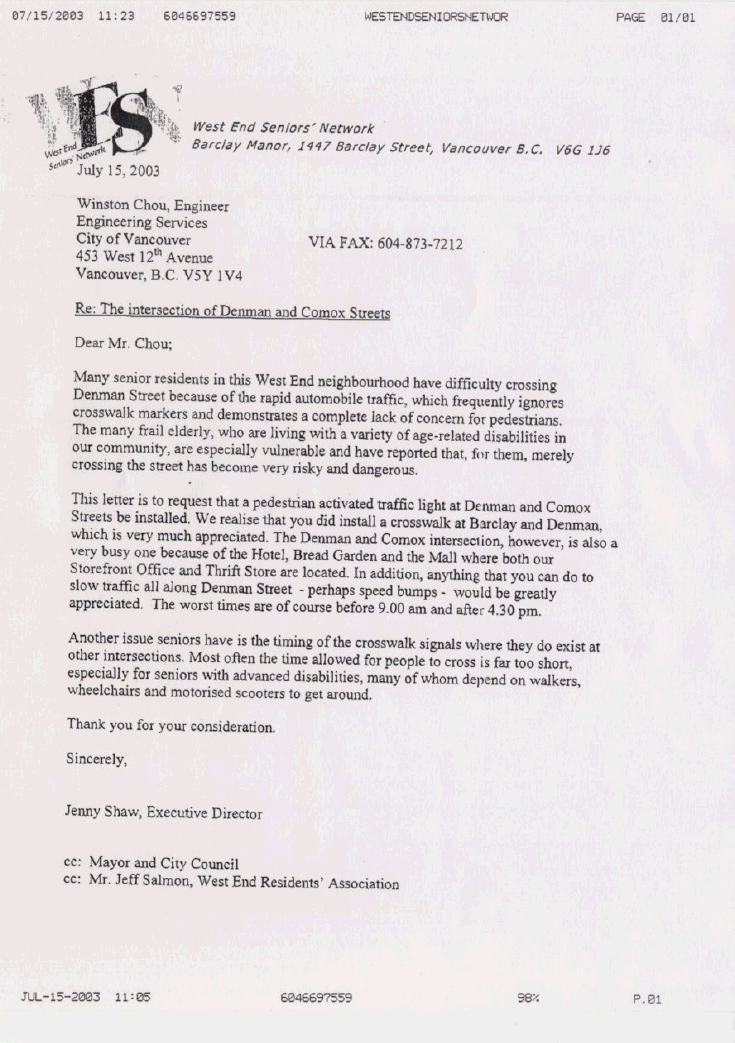
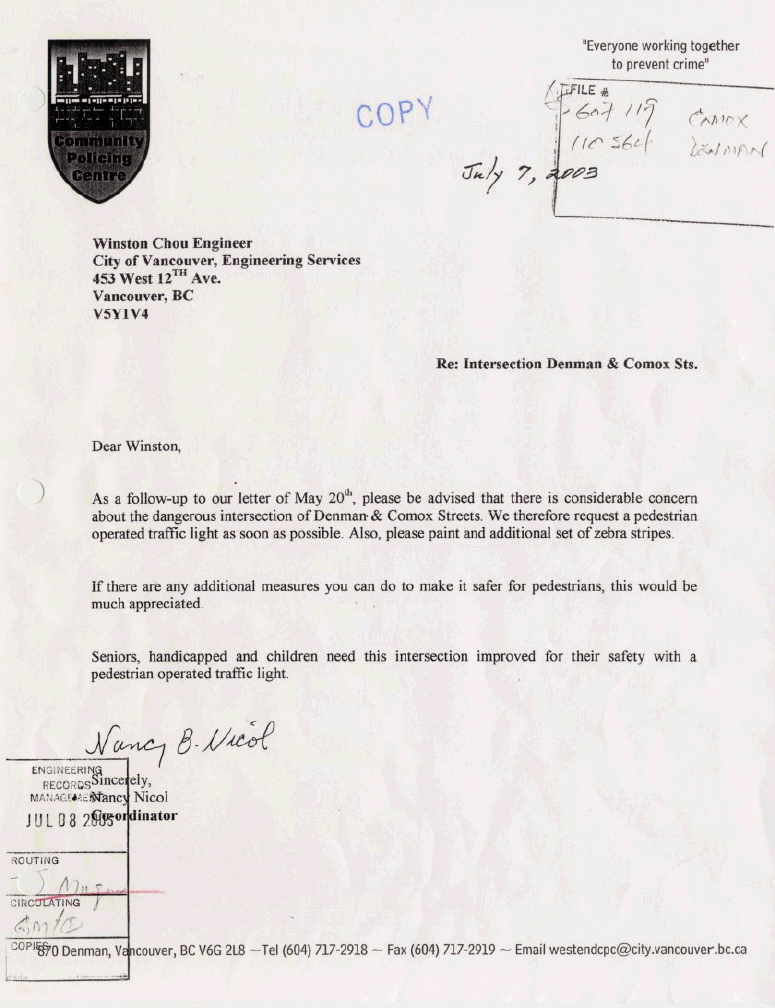
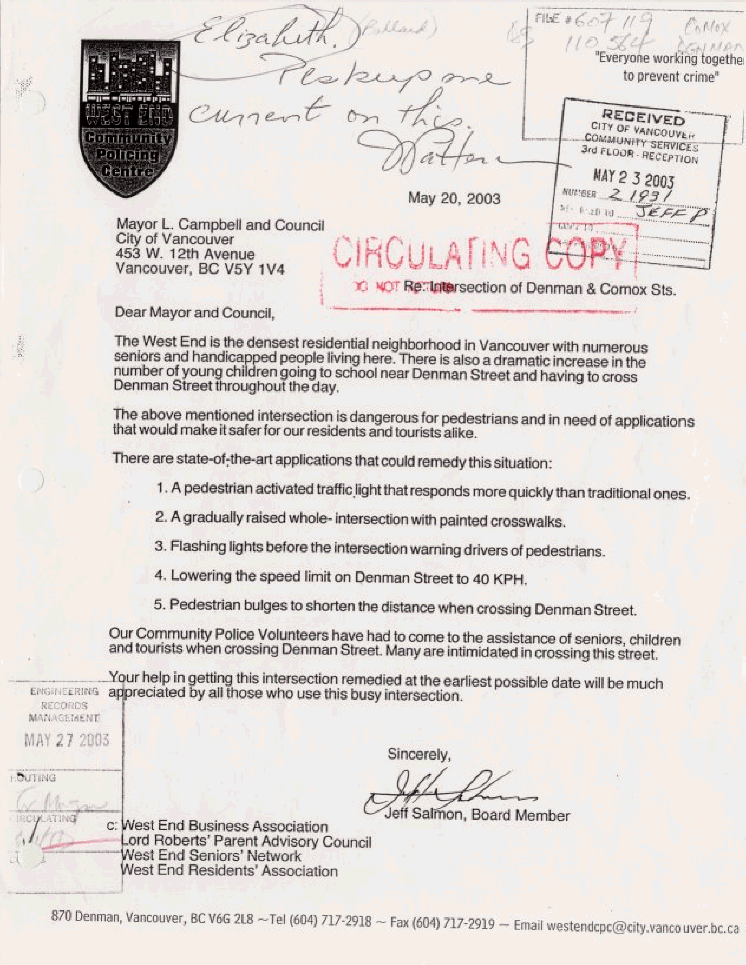

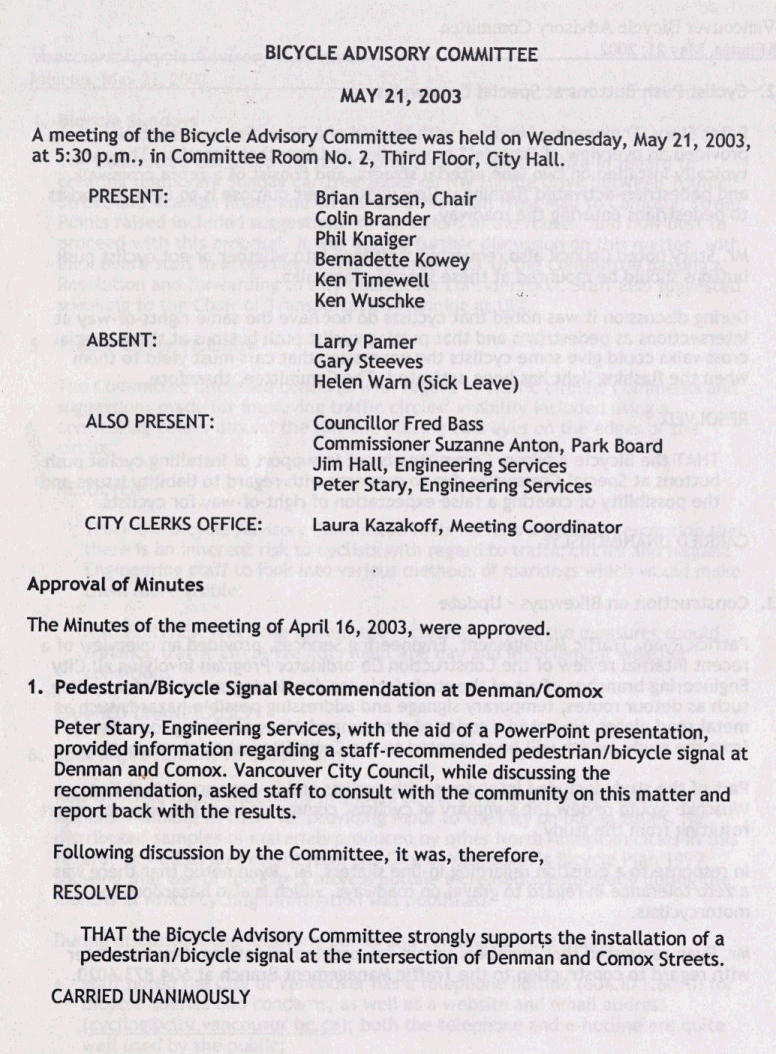
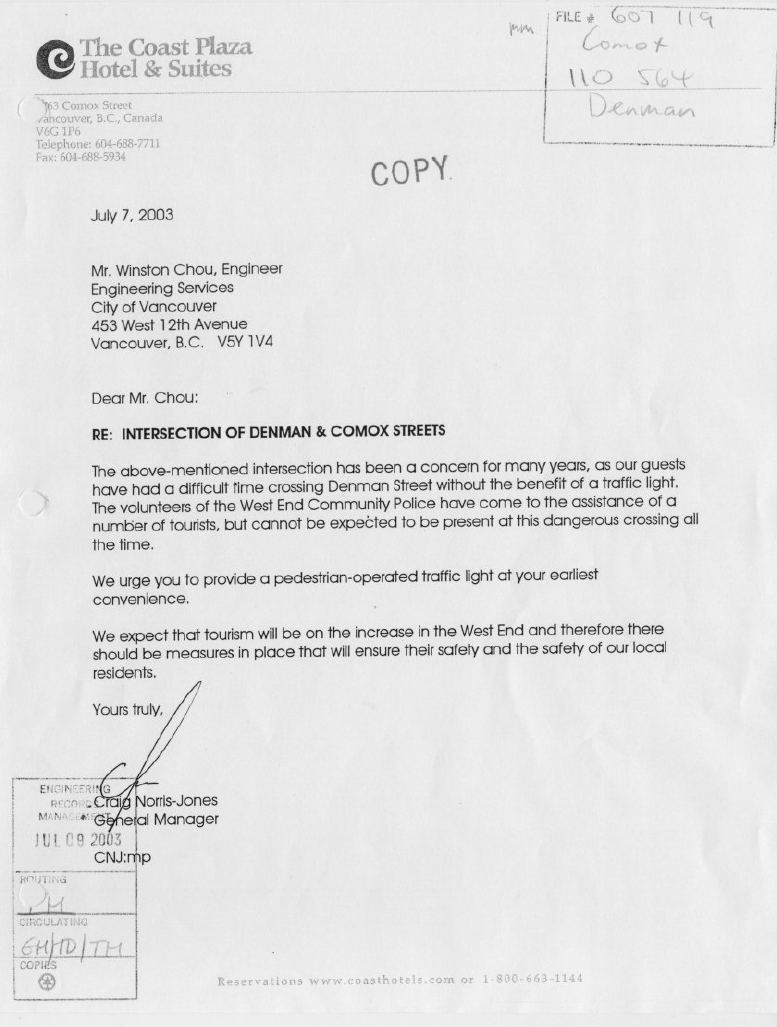
APPENDIX B
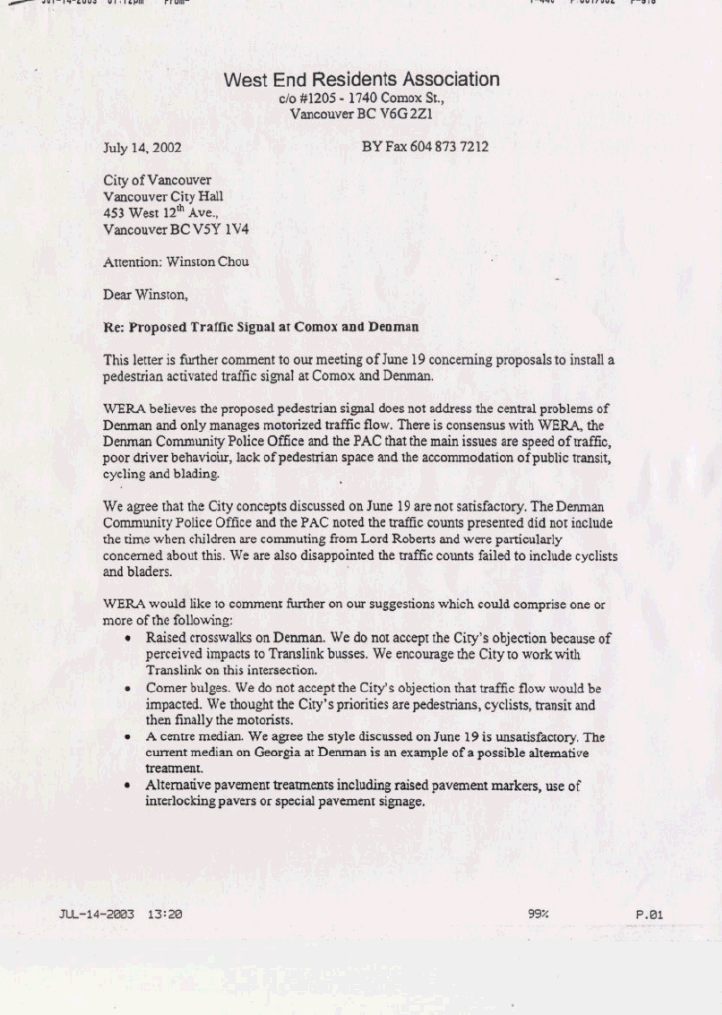

APPENDIX C
Corner Bulges
Corner bulges have proven to be effective measures in enhancing pedestrian crossings at unsignalized intersections. Specifically, they help to: decrease pedestrian crossing distances; increase visibility of pedestrians and motorists; prohibit motorists from parking too close to the crosswalk; and calm traffic conditions.
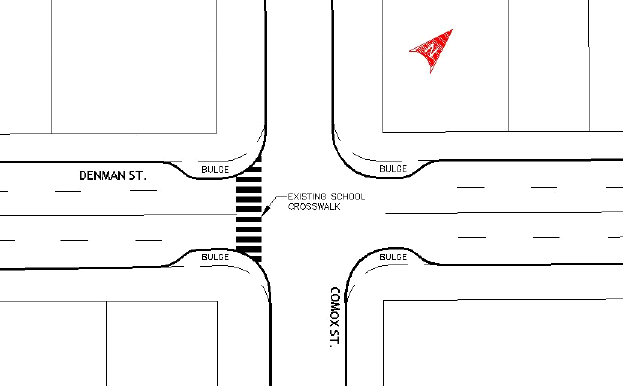 Figure 1 - Corner Bulges
Figure 1 - Corner Bulges
Figure 1 depicts a conceptual design of corner bulges at Denman and Comox. This design would accommodate future considerations for full-time parking and bike lanes on Denman, which are being reviewed as part of the Downtown Transportation Plan. However, the installation of bulges would eliminate the potential for designated bus lanes on Denman unless they are removed. Furthermore, the concern with this design lies in the approaches and departures to the intersection. By narrowing the street cross-section from 4 to 2 lanes, any motorist attempting to make a left or right turn from Denman onto Comox would create a trap, stopping all vehicles following behind. This would result in added congestion and introduce further delay for transit buses along this route. Recent traffic counts showed that there are up to 30 left turns and 50 right turns during the peak hour in the afternoon. Due to these concerns, corner bulges are not recommended at this location.
Centre Median
Similar to corner bulges, centre medians are used to calm traffic conditions. They help to enhance the crossing by providing an island to allow pedestrians to cross one direction of traffic flow at a time.
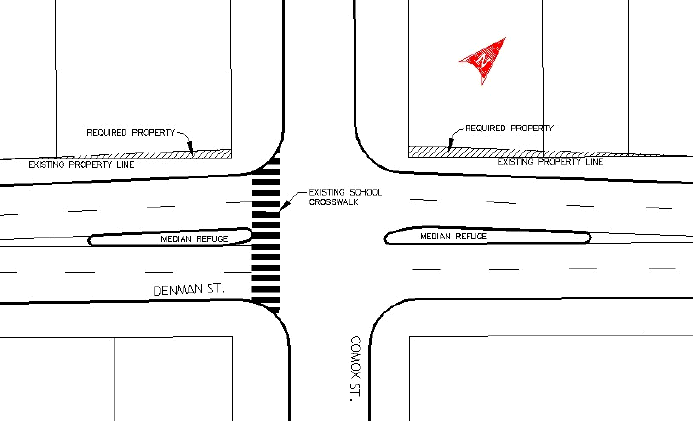 Figure 2 - Centre Median
Figure 2 - Centre Median
Figure 2 is an illustration of a centre median at the intersection of Denman and Comox. In order to address the issue of trapped vehicles, as noted in the previous section, the existing 4 lane cross-section on Denman was maintained in this design. The installation of a centre median would still accommodate full-time parking and bike lanes on Denman if recommended in the future. However, the existing street width on Denman would not be wide enough to maintain the existing sidewalk widths, a 4 lane cross-section, and the centre median. Therefore, the City would need to acquire a portion of adjacent properties, as shown in the hatched area in Figure 2. Considering these properties would have to be redeveloped in order to acquire this property, the centre median would not be feasible in the near future. As a result, this option is also not recommended, at this time.
Speed Humps & Raised Crosswalks
Speed humps have been used on local residential streets and have shown to be effective in decreasing speeds. Raised crosswalks are similar in design to speed humps however, they are located at the intersection and are built wide enough to accommodate a pedestrian crosswalk. This helps by increasing motorists' awareness of pedestrians in the crosswalk and forcing motorists to slow down when approaching the intersection.
Due to the physical nature of speed humps and raised crosswalks, their use has been limited to local residential streets. Currently, Denman Street is classified as an arterial and serves as an important circulation street in the West End for trucks, buses, and emergency vehicles. TransLink's Transit Infrastructure Guideline does not support the use of speed humps on bus routes for reasons of passenger safety and comfort, operational efficiency, and vehicle maintenance implications. In addition, the installation of speed humps or raised crosswalks along Denman would affect emergency vehicles and may interfere with their timely response to emergencies. For these reasons, speed humps and raised crosswalks are not recommended.
Special Crosswalks
Special crosswalks consist of pedestrian-activated flashing amber beacons, overhead internally-illuminated crosswalk signs, additional lighting for the crosswalk, and zebra pavement markings. This device is intended to warn motorists of pedestrians at the crosswalk.
A special crosswalk was considered as an alternative to enhance crossing conditions at Denman and Comox. However, based on detailed reviews of pedestrian profile and volumes, driver courtesy, and gaps in traffic, it was determined that a pedestrian-controlled signal would be a more suitable device to assist pedestrians at this location.
Pedestrian-Controlled Signal
Pedestrian-controlled signals have been used in Vancouver since 1949 and the City has more of these signals than any other city in Canada. Pedestrian signals have proven to be the most effective tool in assisting pedestrians crossing the street as the signal forces motorists to stop for pedestrians.
Recent studies have shown that there are high volumes of seniors crossing at Denman and Comox, and that motorists' are inattentive to pedestrians in the crosswalk. During the AM and PM peak periods, there are few adequate gaps for pedestrians to cross and some motorists stop on the crosswalk area forcing pedestrians to walk between cars. Staff have also received strong support from a number of community groups in the West End. Furthermore, both Denman and Comox Streets are being considered for future greenways and the installation of a pedestrian signal would not preclude future design options to assist cyclists and pedestrians along this route.
The installation of a pedestrian-controlled signal may introduce minor delays for pedestrians attempting to cross Denman. However, with the high number of seniors and school children crossing at this location, the benefits of a signal outweigh this disadvantage. For these reasons, staff recommend a pedestrian-controlled signal at Denman and Comox.